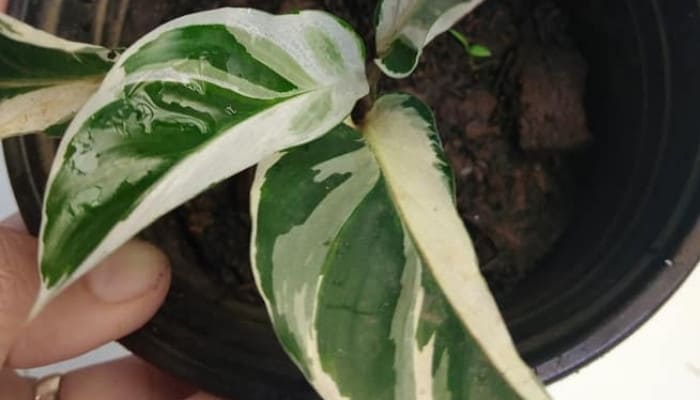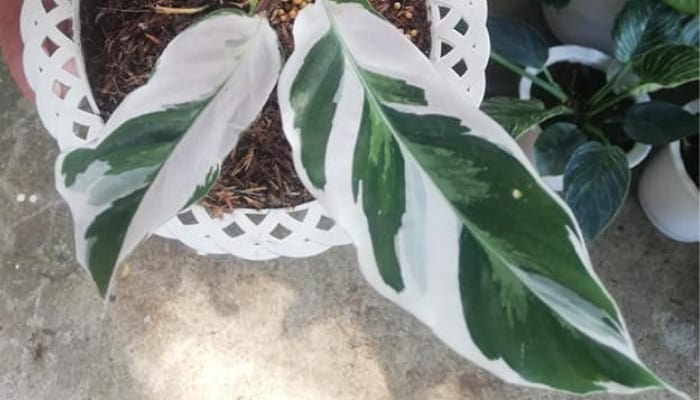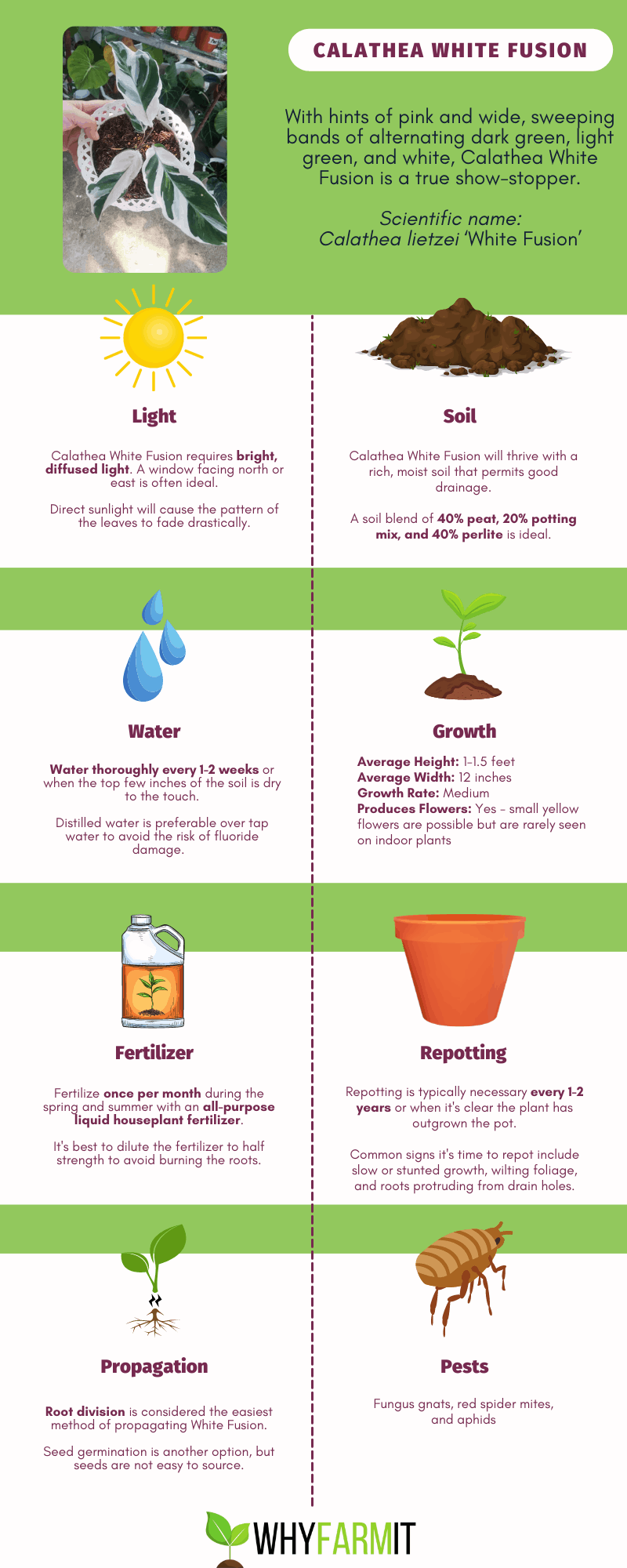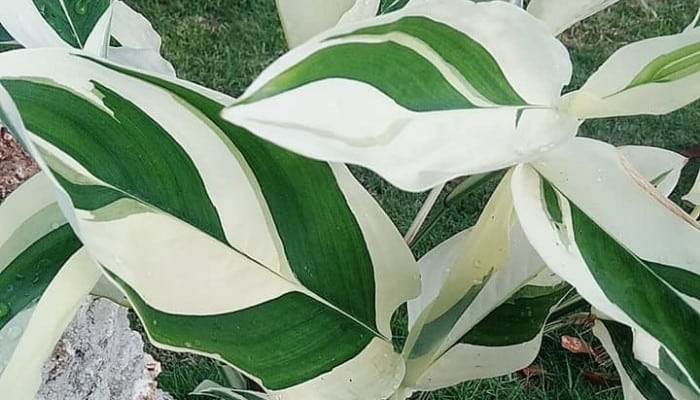Calathea ‘White Fusion’ plants, commonly known as peacock plants for their eye-catching foliage, impress with their marbled green and white leaves that feature tinges of pinkish lilac on their undersides and stems.
With poor management, however, its impressive pattern is at risk of fading altogether.
How do you care for Calathea White Fusion? In order to thrive and maintain the correct foliage color, Calathea ‘White Fusion’ plants require a light, moist soil; bright, indirect light; temperatures between 60-80°F; 75-85% humidity, and a diluted houseplant fertilizer applied once a month during the growing season.
Caring for Calathea White Fusion: Basic Guidelines
As you’ll discover, this particular variety of Calathea can be a temperamental plant to contend with, but if you’re willing to get on board with its daily needs and ideal conditions, owners will delight in keeping this rare and enchanting house plant.
Let’s delve into what the Calathea ‘White Fusion’ needs for successful growth, plus pro tips on pest control, FAQs, and more.
Complete Care Guide for Calathea White Fusion
A fairly recent variety, Calathea ‘White Fusion’ was a chance discovery of Malaysian inventor Taiyan Yam in 2007 from cuttings of its parent plant Calathea lietzei.
Straying from its parent plant’s moderate green variegation, the resulting “offspring” produced the eye-catching light/dark green and white marbled effect that has made subsequent reproductions of this house plant so sought after in recent years.
Calathea White Fusion at a Glance
- Plant Type: Herbaceous perennial
- Scientific Name: Calathea lietzei ‘White Fusion’
- Average Height: 1-1.5 feet
- Average Width: 1 foot
- Growth Rate: Medium
- Produces Flowers: Yes
- Common Pests: Fungus gnats, aphids
- Life Expectancy: Years with good care
- Difficulty of Care: Medium
What To Do When You First Get Your Calathea White Fusion
- See if it needs a drink – it loves to be in moist soil, so check the top 2 inches with your finger to see if it is dry and in dire need of watering. If it feels moist to the touch, check back later.
- Check its soil drainage – check the bottom of the plastic nursery pot to see if it drains well after watering. If drainage is poor this denotes soggy soil which can cause root rot, so take steps to correct the soil (detailed below).
- Prep its environment – pick a shady spot and ensure its ideal humidity and temperature levels are met so it can start enjoying its micro-climate.
Ideal Soil for Calathea White Fusion
This plant needs moist soil with good drainage, so the following potting soil recipe will be ideal:
- 40% peat moss – to help it retain enough moisture.
- 20% commercial potting soil – to support the plant and help deliver nutrients.
- 40% perlite – natural, lightweight granules added to aerate the soil and improve drainage.
Calathea White Fusion Water Requirements
Watering may be needed every 1 or 2 weeks depending on the soil’s condition.
It’s a good rule of thumb to feel the top soil layer every other day to determine the best watering schedule, recommends collector and Plantophiles blog creator Marcel Iseli:
“In time you’ll become an expert in knowing exactly when to water your finicky baby.”
Use distilled water or tap water that has been left overnight for the fluoride content to evaporate.
I prefer distilled water over tap water, hands-down.
Calathea White Fusion Lighting Needs
To ensure it thrives without fading its gorgeous foliage pattern, place your Calathea ‘White Fusion’ well away from direct sunlight.
It needs diffused indirect light, so a north or east-facing window will be perfect.
Otherwise, use a sheer curtain to provide enough shade if direct light is inescapable.
Also, consider fluorescent lighting to help them grow in darker locations or during long winters.
Ideal Temperature Range for Calathea White Fusion
To replicate the consistent warmth of the tropics, White Fusions love a temperature range between 60 and 80°F (15-26 °C).
Disease and foliage discoloration can occur in temperature extremes outside this range, so keep your plant far from air conditioners, drafts, or heaters.
Ideal Humidity Level for Calathea White Fusion
Humidity levels of 75% and above will be best to mimic its original rain forest conditions.
If your home is air-conditioned, try to increase levels with a humidifier or setting up a pebble tray for a quick budget hack.
Be sure not to let humidity levels exceed 85% as this is rife territory for pests and certain diseases.
Best Location for Calathea White Fusion
Humid areas that can provide adequate shade are ideal, so this could be the bathroom (as long as it isn’t in the splash zone).
Low-light corners of your kitchen or office/study area can also be ideal spaces, ensuring humidity and temperature conditions are met.
Calathea White Fusion Growth Habits
Calathea ‘White Fusion’ plants are compact, upright shrubs that develop in a bushy form with the lower leaves growing in clumps with a slight arch to their shaping.
Fertilization Type & Schedule for Calathea White Fusion
This plant can be fed on all-purpose water-soluble houseplant fertilizer once a month during the growth season (spring to fall).
Be sure to dilute any solution to half strength to prevent burning the roots. DIY organic fertilizer is a cheaper, chemical-free alternative to encourage growth.
Signs of Nutrient Deficiency
Foliage will appear to crisp or curl up and the edges and tips may turn brown when it is lacking nutrients.
This usually points to an environment with too low humidity, poor root health as a result of overwatering, or when the roots are starved of nutrients due to little watering.
Pruning Calathea White Fusion
Though regular pruning won’t be necessary, keep an eye out for signs of dying leaves (browning edges, curling) and trim these as necessary.
Trim in line with the leaf’s shape with specialized plant trimming scissors.
Any dead foliage (faded pattern, excessive discoloration, wilting, etc.) should be removed at the base of the stalk where it joins at the stem using pruning shears.
Does Calathea White Fusion Produce Flowers?
While they produce small yellow flowers in their wild habitat, Calathea White Fusions rarely flower indoors and are grown instead for their distinctive and decorative marbled foliage.
Is Calathea White Fusion Toxic?
No, this plant along with all Calathea varieties is nontoxic to pets, according to the ASPCA (American Society for the Prevention of Cruelty to Animals).
Calathea White Fusion Propagation
Propagating (creating new plant cuttings from the parent plant) can be done using seed germination.
However, as White Fusion Calathea seeds are quite hard to come by, propagation by root division is the method most commonly used.
1. Fill Your New Pots With Soil for Quick and Easy Planting
Prepare as many new pots as you think you’ll need by filling them 1/3 of the way with your chosen soil recipe.
This will make replanting the divided offspring more efficient and prevent the root sections from going too long without much-needed moisture and nutrients.
2. Remove the Parent Plant From Pot & Gently Break Apart Soil
Carefully slide your plant out of its container pot and begin removing the soil to expose the root balls you’ll be dividing the plant into.
The soil should be easily broken up by hand, but you can use a sterilized knife if you find it feels tough.
3. Examine the Roots for Spoilage & Trim With Plant Scissors as Needed
Once the root system of your plant is fully exposed, check for any black, mushy patches.
Healthy roots should be pale in color and feel firm, so trim off any damaged root sections as necessary with disinfected plant scissors.
4. Carefully Divide Root Ball Sections & Begin Replanting
You’ll see that the roots branch off into their own systems or “root balls” from the main root crown.
Identify these root ball sections and carefully separate these from each other.
Lastly, place each new root section in the center of their prepared pots, and fill each one with the remaining 2/3 of soil, patting the top lightly to stabilize them well.
Water each one, and find a suitable new home for them!
Repotting Calathea White Fusion
Your Calathea ‘White Fusion’ will need to be repotted in new soil now and then depending on its environmental conditions and how often you fertilize it.
When To Repot Calathea White Fusion
This plant will typically need repotting every 1-2 years when it has become apparent that it has outgrown its current pot or is struggling to grow, displaying wilted leaves.
Over time, roots can grow to the point of becoming rootbound – this is when they take up too much space within the soil to allow for adequate nutrient intake and start protruding beneath the drainage holes.
Signs That It’s Time To Repot
- Noticeably slow or stunted growth
- Roots poke through drainage holes and circle the soil
- Wilting foliage due to dehydration
How To Repot Calathea White Fusion
1. Water Your Plant Beforehand for Easy Removal & Prepare New Pot
Per your watering schedule, make sure your plant has had a recent drink so it will be soft and easier to slide out from its container pot.
In a clean, new pot (roughly 2 inches larger than your current one) fill it a 1/3 of the way with the ideal soil mix.
2. Remove the Plant From Its Old Pot & Check Root Health
Carefully remove the plant from its existing container pot, and gently brush off the old soil by hand, taking care not to shake it too vigorously.
Once the roots are exposed, check for any diseased sections that may need trimming, and gently untangle any entwined roots.
3. Place the Plant Into Its New Pot & Water It Well
Put your Calathea ‘White Fusion’ into the center of its new, larger container pot, and fill it with the remaining 2/3 of soil mix – patting lightly on the soil surface to secure it.
Water your new plant thoroughly, checking its drainage, and place it in a humid area with indirect light.
Calathea White Fusion Common Problems & Solutions That Work
Calathea White Fusion Common Pests
The warm conditions favored by this plant can also be favored by nuisance critters looking to feed on the foliage.
Fortunately, common pests are easy to deal with if you take the time to inspect the leaves often.
Fungus Gnats
- Signs of Trouble – Wilted, yellowing foliage. Small black flies buzzing near the plant.
- Solution – Trim affected leaves and use nematodes (microscopic worms that seek out and eat gnat larvae in the soil) or sticky traps like these.
- Prevention – Spray the leaves with neem-oil (organic leaf polish that doubles as insect repellent).
Red Spider Mites
- Signs of Trouble – sticky webbing, faded “off” looking leaves, small brown spots.
- Solution – Horticulturist Jennifer Gibson at the Good Earth Garden Center recommends “placing a piece of white paper underneath leaves and tapping the leaf to check for small red moving dots.” Remove remaining mites and webbing with a tepid shower.
- Prevention – Mist regularly to increase humidity and introduce the predatory mite Phytosieulus persimilis to keep numbers down.
Aphids
- Signs of Trouble – Gathering of small green/gray flies hiding on leaf undersides. Sticky honeydew on leaves and stems.
- Solution – Spray them with a mister bottle filled with warm, soapy water.
- Prevention – Check the leaf undersides often and spray foliage with organic repellent like neem oil (I use this one – works great!) or similar.
Calathea White Fusion Common Diseases
If your plant is living in excess moisture, the combined high humidity levels make this ripe for fungal and bacterial diseases to set in.
Here are two that most commonly affect the Calathea ‘White Fusion’:
Root Rot
- Signs of Trouble – Black pulpy roots, poor growth, discolored foliage.
- Solution – Prune spoiled roots and re-pot healthy root sections in fresh soil.
- Prevention – Improve aeration and drainage in the soil with perlite. Review watering regimen.
Nutrient Deficiency
- Signs of Trouble – Curled or brown-tipped leaves, dull leaf pattern, slow growth.
- Solution – Trim affected leaves and repot in fresh soil mix.
- Prevention – Review your watering schedule. Check soil regularly for moisture or dryness. Ensure soil mix has good drainage and moisture retention.
Other Common Problems
When pests and diseases aren’t to blame, this fussy plant will let you know that conditions are far from ideal by exhibiting the following symptoms on the foliage:
Wilting Leaves
- Signs of Trouble – Limp drooping leaves, possibly faded pattern.
- Solution – Check top soil layer for dryness or overly moist soil and treat accordingly.
- Prevention – Ensure lighting and temperature conditions are ideal. Reassess watering frequency.
Holes in the Leaves
- Signs of Trouble – small holes in the foliage (not to be confused with brown holes/spots created by red spider mites).
- Solution – Trim affected leaf areas as needed, and cut down on fertilizer use as too much leaves salt to accumulate on the leaves.
- Prevention – Refrain from fertilizer use for a while. Review temperature and humidity levels as lower levels combined with high temperatures increases the risk of leaf burn.
Yellow Leaves
- Signs of Trouble – Yellow leaf tips or large yellow patches.
- Solution – Check soil’s drainage quality, and increase aeration by poking a chopstick in the soil. Trim or prune leaves depending on the damage, and repot healthy stems.
- Prevention – Switch to a well-draining soil mix with a higher ratio of perlite material (such as orchid bark) to open up the soil and improve nutrient intake.
Calathea White Fusion Common Questions

Is Calathea White Fusion Rare?
Sophie Nadeua, Calathea enthusiast and curator of the plant-care blog The City Wild, shares that the Calathea ‘White Fusion’:
“is rarer than other Calathea varieties and can be harder to find in garden centers. As such, it’s often sold with a higher price tag than its more common counterparts.”
How Much Does a White Fusion Calathea Cost?
Due to its distinctive and highly treasured foliage variegation, these White Fusion Calathea plants can cost between $70 and $95 depending on the retailer.
How Do You Keep Calathea White Fusion Happy?
Do your best to replicate lush rain forest conditions by maintaining ideal humidity and temperature, and take the time to learn its preferred watering routine by testing the soil regularly with your finger.
Also, inspect regularly for pests, use filtered water, and opt for organic pesticides and fertilizer.
Should You Mist Calathea White Fusion?
White Fusion Calathea benefits from regular misting as it requires quite high humidity levels.
If you don’t have a humidifier, mist the leaves around three times a week, taking care not to overdo it as leftover water droplets will run into the soil and make it overly moist, risking nutrient deficiency and possible root rot.
Does Calathea White Fusion Pray?
All Calathea plants are part of the Marantaceae “prayer plant” family but are not true “prayer plants” like their relatives in the Maranta genus.
True prayer plants possess a mechanism known as nyctinasty which sees their leaves fold up at night in “prayer” and open up at sunrise.
Calathea White Fusions are known to move their leaves in response to changes in light but not due to a circadian rhythm.
Why Does My Calathea Fusion White Have Brown Tips?
Brown leaf tips can indicate that your plant has been unevenly watered. Incorrect fertilizer use could also be the culprit.
Be sure to water your plant before applying a water-soluble fertilizer, and always dilute the strength by half, as applying to dry soil can risk burning the roots and discoloring foliage.
Can a Calathea White Fusion Revert?
Calathea ‘White Fusion’ plants can revert – a process whereby variegated foliage plants revert to an all-green appearance.
This is usually because “variegated plants are selected from a mutation of a pure-green plant” according to the Royal Horticultural Society.
Widespread reversion cannot be cured, but if localized to one leaf, propagation may preserve variegated foliage.
Does Calathea White Fusion Like Coffee Grounds?
The ideal soil recipe for Calathea Fusion Whites veers slightly towards an acidic pH, so yes, coffee grounds can be combined with regular potting soil to lend acidity and act as a natural fertilizer.
Use 1 part coffee grounds with 3 parts commercial potting soil, taking care to use only plain black grounds with no additives as this can risk fungal diseases.
Why Is My Calathea White Fusion Curling? 
Curling leaves are often the result of underwatering, sunlight exposure, or overly high humidity, so try to adjust these to this plant’s ideal conditions.
A hygrometer (a simple humidity monitor like this one) is a great way to keep track of levels, and daily monitoring of the top soil layer can help determine a consistent watering timetable.
Calathea White Fusion vs. Triostar
The Stromanthe ‘Triostar’ plant is a Calathea relative and shares a similar variegated marble coloring in its foliage to Calathea ‘White Fusion’, though the Triostar has longer, more slender leaves.
While both require high humidity and similar soil needs, Triostars are more tolerant of cooler temperatures.
Calathea White Fusion vs. Calathea White Star
Calathea ‘White Star’ plants possess a defined white-and-green striping in their foliage compared with the softer marbled effect of Calathea ‘White Fusion’.
Both thrive in the diffused light and high humidity of their native tropics, though White Stars grow to be much taller plants, reaching an average height of around 4-5 feet. See them here.
Are Calathea and Maranta the Same?
Calathea and Maranta plants are a close relation, and both belong to the same family of Marantaceae plants, but each plant is a separate genus within this family.
Despite sharing many similarities in their care needs, natural habitat, and appearance, these are two different plant types.
3 Key Tips for Success With Calathea White Fusion

1. Don’t Let the Beautiful Foliage Fade – Provide Perfect Light Conditions
The main draw to the Calathea ‘White Fusion’ is its striking leaf pattern, so keep this intact for as long as possible by keeping it in its ideal diffused light location.
Too much direct sunlight will cause the leaves to fade, burn, and ultimately revert to all-green leaves.
2. Consider Going Organic With Your Soil, Fertilizer & Pesticide
Wherever possible, try using organic alternatives to commercial soils, fertilizers, and sprays.
Raffaele Di Lallo of Ohio Tropics advocates going organic with perlite and food scraps for the “slow-release of nutrients over time, so you won’t have to fertilize as often or worry about salts causing brown leaf tips.”
3. Propagate/Repot in Springtime To See the Best Results
Carrying out these processes at the start of the natural growing season is the best way to safeguard your plant against the “shock” of being rehomed.
Encouraging regrowth when the plant is most resilient will help you produce a healthy, long-lasting plant.
Conclusion
To summarize, the Calathea ‘White Fusion’ plant requires a fair amount of TLC to maintain good health from the roots to its beautiful foliage.
As this is a plant mutation, you’ll need to keep a close eye on environmental conditions to prevent reversion and a closer eye still on potential pests and signs of disease to enjoy this tropical stunner for many years.

Image credits: Lovella De los Santos, Ryle’s Enoch Garden, Steph Garden
Sources:
https://patents.google.com/patent/USPP26187P2/en
https://www.aspca.org/pet-care/animal-poison-control/toxic-and-non-toxic-plants/calathea
https://www.conservatoryarchives.co.uk/online-store-plants/calathea-white-fusion
https://plantophiles.com/plant-care/calathea-white-fusion/
https://indoorgardenook.com/calathea-white-fusion-care/
https://gardengoodsdirect.com/products/calathea-white-fusion
https://thegoodearthgarden.com/our-newest-houseplant-white-fusion-calathea/
https://anselandivy.com/blogs/plant-care/white-fusion-calathea
https://thecitywild.com/calathea-white-fusion-care-guide-calathea-lietzei/
https://www.reddit.com/r/plantclinic/comments/dawm1b/help_me_make_my_calathea_white_fusion_happy/
https://www.google.co.uk/books/edition/Plant_Canopies/qDSEjj91qNkC?hl=en&gbpv=0
https://flourishingplants.com/how-to-mist-plants-misting-and-humidity-explained/
https://www.gardeningknowhow.com/houseplants/calathea-plants/calathea-vs-maranta.htm
https://www.gardeningknowhow.com/plant-problems/environmental/variegated-plant-problems.htm
https://www.indoorplantsforbeginners.com/do-indoor-plants-like-coffee-grounds/

